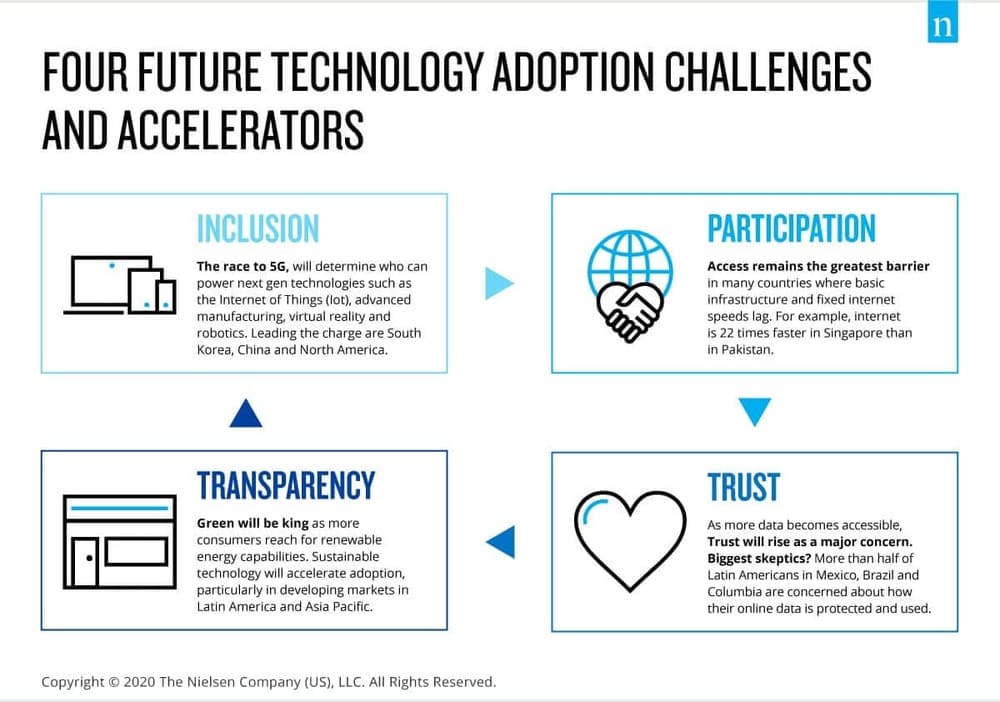As a product marketing team, you need to understand what technology your customers are using and how they adopt it. Tech adoption intelligence provides actionable intelligence for business decision-makers who need it and marketers alike.
As a tech marketer, tech adoption intelligence is your doorway to reach out to technology user in the moment of their need by positioning your product as a medium to mitigate their challenges.

Source : Nielsen
Let’s delve into focus areas where product marketing teams can leverage tech adoption intelligence meeting their client’s project deliverables.
1. Positioning Your Products to Aid Digital Transformation Planning
Digital transformation is a bit of a buzzword for something that is becoming an everyday reality. However, it’s a worthy goal for any business, whether large or small, to reflect the competitive landscape and thrive by transforming their products and services into something more digital-friendly, thus providing increased ROI.
More traditional businesses are slowly adopting digital technologies, while those that still rely on old-fashioned “hard” sales and marketing are beginning to recognize the need for change.
Digital Transformation Planning requires technology adoption at every stage and is needed for their digital presence to compete with current and emerging competitors successfully.
This process is all about “digitalizing” the organization, also called “Digitization.” This is not an easy task as it requires a lot of investments and resources. However, starting from the top of the organization’s chain, this planning phase typically identifies your company’s needs and risks. As a products marketer, this is where you can create the right products by tapping into their technology adoption intelligence.
2. Solutions that Support Product Management
Product managers, like the name suggests, are responsible for managing a product throughout its lifecycle. A product manager’s job scope includes defining the vision for what a company is trying to achieve with the product and deciding how to execute that vision. In addition, they are constantly on the lookout for product management solutions to streamline day-to-day operations.
It’s hard to stand out in today’s world. Developing a product can take years and cost millions of dollars. And even if you do create a novel idea, it doesn’t mean that your target customers will care about it or buy it.
More than just an essential cog in a company’s execution engine, product management is one of the most challenging. So it is good to note that technology products cannot exist in silos. Instead, every technology a company adopts requires a plethora of complementary technology management suits that need to be built.
By diving deep into the existing tech stack and technology adoption intelligence as a product marketer, you can align the most appropriate complementary products that support product management.
3. Aligning Product Suits that Complement Service Design
Some of the most successful companies in the world are those who built a product that people love and a customer service infrastructure so excellent that it made their customers fall in love with them.
The goal of service design is to create clarity and confidence for customers by making solutions easy to understand and be consumed. Serving customer needs directly creates more positive outcomes than business profits primarily determined by external factors such as the economic climate or market trends.
Gaining insights into the technology adoption tools used to provide customer service solutions for clients is a great way to support them with allied product solutions. In addition, by understanding the technology adoption in this space, you can create and promote products of relevance for Service Design.
Product service design is suitable for companies in industries like Information technology, transportation, retail, and finance because it allows them to expand their business model and keep up with trends and innovations in technology.
4. Meeting Marketing Needs and Objectives
It would help if you always had an active marketing strategy to reach new customers, and the best way of doing so is through outreach.
Marketing is a powerful force within any business. The way we live our lives has shaped how marketers create new products and services. It’s up to marketers to deliver an integrated experience via all communications channels, including digital, word-of-mouth, display advertising, etc., that helps customers live their lives more quickly.
To market a product or service successfully in today’s world of new business models, a company must provide customers with an integrated experience across all communication channels.
As a product marketer, by closely monitor your client’s tech stack and technology adoption for marketing automation tools, you can align your product solutions or add-ons accordingly.
In Conclusion
Technology is increasingly becoming a commodity, and it’s been at the forefront of our society. Yet, though technology has brought so many excellent opportunities for people, it also comes with its share of challenges.
We at Span Global Services believe that successful product marketing is all about helping organizations and individuals successfully navigate through this terrain? No better way than diving deep into insights about their technology adoption.
Our technology lists are your best bet for the same. So get in touch with us today!


